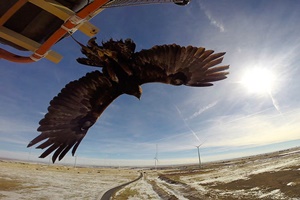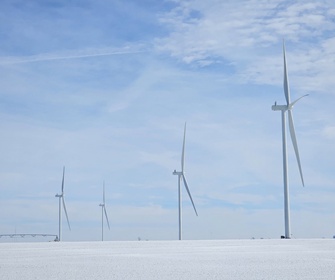 A new software—the Stochastic Soaring Raptor Simulator (SSRS)—developed at NREL with support from the U.S. Department of Energy Wind Energy Technologies Office endeavors to predict the most likely long-distance flight paths of individual golden eagles as they ride updrafts.
A new software—the Stochastic Soaring Raptor Simulator (SSRS)—developed at NREL with support from the U.S. Department of Energy Wind Energy Technologies Office endeavors to predict the most likely long-distance flight paths of individual golden eagles as they ride updrafts.An SSRS user can choose the site, then either provide the wind conditions or ask for a specific date and time. The model, which is publicly accessible on GitHub, will simulate the likely routes golden eagles would take as they travel through the site.
SSRS goes beyond the capabilities of previous agent-based models (with raptors being the “agents”). The simulator incorporates information about an individual site of interest from the ground up while accounting for uncertainties in atmospheric conditions, raptor decision making, and the location where a bird may have been spotted.
The user provides a region of interest, which could be anywhere in the United States, and the model will import terrain features, atmospheric conditions, and turbine locations from publicly available data sources. The model then calculates where favorable updrafts might occur. Finally, the moving parts get added: virtual golden eagles. Starting at randomly or uniformly spaced points of entry, simulated eagles are programmed to minimize their energy expenditure while moving in a particular direction. SRSS simulated paths are then combined to provide a map that shows the eagles’ possible location at any given time.
The simulator is designed to investigate variations in conditions and eagle behavior throughout the year (seasonal) as well as differences throughout the day and night (hourly).
The team tried out a few example cases at both seasonal and hourly scales and compared simulated tracks to real eagle flight paths from GPS-tagged birds taken near three wind power plants during all four seasons in Wyoming. Although the model is two-dimensional and the observed data show vertical changes, the overlap was promising. The presence maps for migrating golden eagles clearly show a measured contrast between southern migration and northern migration for a particular power plant.








